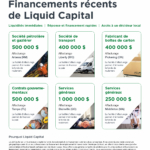How to manage cash flow through uncertainty
Part 1 in our « cash flow through uncertainty » series.

The COVID-19 pandemic has proven a big test for many small and medium-sized businesses. Being able to manage cash flow during its various stages was key to many companies’ survival, but sadly, those who were not prepared did not survive.
Crises can take many shapes: from another pandemic to an unexpected industry meltdown or an abrupt change in a business owner’s personal circumstances.
It pays, therefore, to have tactics and resources ready when faced with times of uncertainty, a crisis or recovery. This forward-thinking planning will give your business a better chance to not only survive the next crisis, but to come out the other side even stronger.
Managing cash flow in uncertain times
During a prolonged period of uncertainty, small and medium-sized companies can’t afford to carry on business as usual. When you can’t be sure of what’s around the corner, you need to be prepared for what might be up ahead. Having solid cash flow is essential to ensure that you can keep producing your products or service, pay your staff and keep the lights on.
There are a number of strategies you can use when uncertainty makes it difficult to plan with any accuracy:
1. Set up financing options
It can be a lot easier to put financing in place before you actually need it. One strategy is to arrange for a rolling line of credit in case cash flow becomes tight. The big advantage of a line of credit is that you don’t pay interest until you use it. It’s extremely flexible and allows you to borrow and pay back at any time. You may never need it but setting it up now could help you to survive if things go sideways. It can also help you to have peace of mind, knowing that you have a back-up option if cash becomes tight.
2. Factor your way ahead
Since many businesses are already extended on their credit or cannot qualify for traditional financing, you may also consider invoice factoring as another way to improve your cash flow in uncertain times. By accessing working capital based on selling your open invoices, you won’t go further into debt and you can gain immediate inflows — and you won’t be paying interest or penalties compared to other types of financing.
3. Hit the growth pause button
Going ahead with aggressive (or even moderate) growth plans during uncertain times can be devastating. Stretching your finances by expanding, taking on more real estate or increasing your employee count may not always be a good idea if the economy is on the verge of a dip. Put those expansion plans on the back burner until you feel that the situation has become steadier and more predictable.
4. Reassess your inventory
Take a good look at your stock and see if there is anything that can go. Inventory that you know can take a long time to sell, or an excess amount of any particular stock could be cleared out quickly to turn it into much-needed cash. You could either offer it to your best clients in a discounted flash sale or sell it to a liquidator.
5. Take a ruthless look at your costs
Improving your cash flow in uncertain times provides the ideal opportunity to go over your costs in minute detail. Cancel or pause anything that is not absolutely essential to the successful running of your business. Any savings you can make now will help keep your cash flow healthy if things take a turn for the worse.
Get our Cash Cycle Guide for smart strategies to maintain positive cash flow.
6. Find a trusted alternative finance partner
We would be remiss not to include this tip. You likely have a finance partner at a traditional financial institution, but you should also have alternatives in place if the bank says no. At Liquid Capital, we work alongside you and your banking partner to ensure you get the right mix of financing when you need it.
Uncertain times can escalate quickly, especially when a true crisis hits. By getting ahead of the issues, you’ll be prepared to get through a downturn in the market and keep your business prosperous.
Up Next: Sail through a cash flow crisis — 5 places to batten down the hatches






